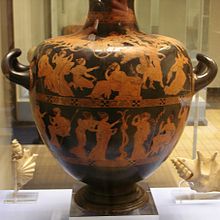Meidias (potter)
Meidias ( Greek Μειδίας ) was a Greek potter who lived at the end of the 5th century BC. Chr. In Athens worked.
plant
His signature can only be found on a around 410 BC. Chr. To dating Hydria from the former collection William Hamilton who now in the British Museum is (inv. No. E 224). The vase was from a vase painters in the Attic - red-figure painted style that, pursuant to its provisional names Meidias Painter received. It is decorated with the themes “Rape of the Leukippids ” and “ Heracles in the Garden of the Hesperides ” and is characterized by the harmony of the vessel parts.
reception
The hydria became one of the most discussed Greek vases as early as the 18th century because of the then open questions about its origin and iconography. She gained particular fame through her publication in Pierre-François Hugues d'Hancarville's Antiquités étrusques, grècques et romaines , which contains images of her. Josiah Wedgwood used these illustrations as a model for the production of stoneware in his porcelain factory , in which the shapes and decorations of Greek ceramics were imitated. The popularity of this Wedgwoodware meant that both the shape of the hydria and its iconography found their way into the most diverse genres of the visual arts of the 18th and 19th centuries.
literature
- Rainer Vollkommer : Meidias (I) . In: Rainer Vollkommer (Hrsg.): Künstlerlexikon der Antike . Volume 2: L-Z. Addendum A – K. Saur, Munich / Leipzig 2004, ISBN 3-598-11414-1 , pp. 58–59.
Individual evidence
- ↑ Antoine Hermary: Dioskuroi No. 201 . In: Lexicon Iconographicum Mythologiae Classicae (LIMC). Volume III, Zurich / Munich 1986, p. 584.
- ↑ Georgia Kokkorou-Alewras: Herakles No. 2717 . In: Lexicon Iconographicum Mythologiae Classicae (LIMC). Volume V, Zurich / Munich 1990, p. 104.
- ^ Pierre-François Hugues d'Hancarville: Antiquités étrusques, grècques et romaines. Tirees du cabinet de M. Hamilton . Naples 1766-67. Volume 1, panels 127-130; Volume 2, plate 22.
- ↑ Wedgewood vase based on the model of the Meidias hydria, 1780 .
Web links
| personal data | |
|---|---|
| SURNAME | Meidias |
| BRIEF DESCRIPTION | Greek potter |
| DATE OF BIRTH | 5th century BC Chr. |
| DATE OF DEATH | 5th century BC BC or 4th century BC Chr. |
